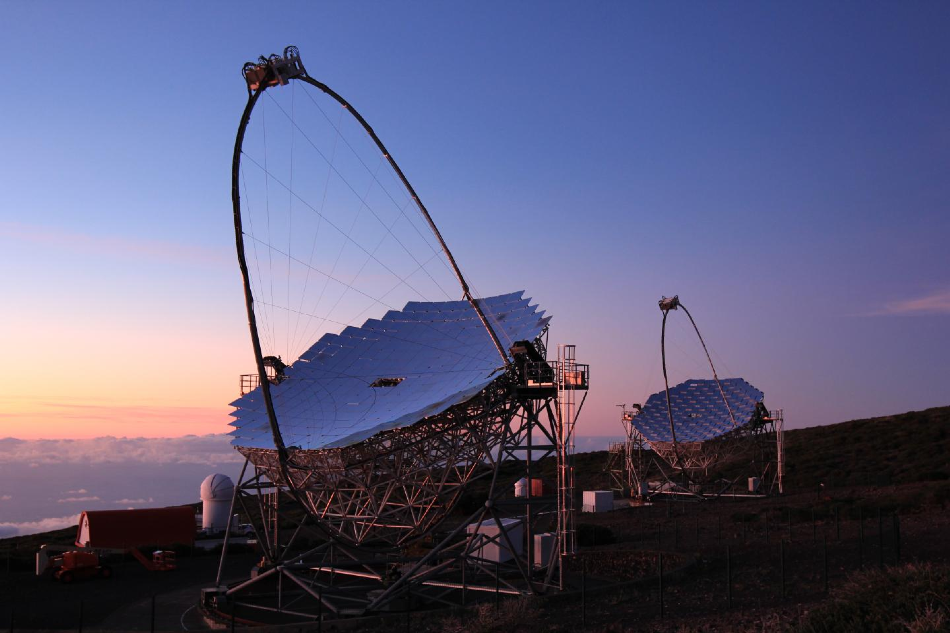Jul 13 2020
The first Gamma-Ray Burst (GRB) at extremely high energies was detected by the MAGIC telescopes in 2019. This was the most powerful gamma-radiation to be ever emitted from this kind of a cosmic object.
 The MAGIC telescope system at the Roque de los Muchachos Observatory, La Palma, Canary Islands, Spain. Image Credit: Giovanni Ceribella/MAGIC Collaboration.
The MAGIC telescope system at the Roque de los Muchachos Observatory, La Palma, Canary Islands, Spain. Image Credit: Giovanni Ceribella/MAGIC Collaboration.
However, the GRB data offers more: with additional studies, the MAGIC researchers could presently prove that the speed of light remains constant in vacuum and does not rely on energy. Hence, similar to several other tests, the GRB data also confirms the theory of General Relativity (GR) developed by Albert Einstein. The research has been recently published in the Physical Review Letters journal.
Einstein’s GR is an interesting theory that describes how interactions occur between energy, mass, and space-time, producing a phenomenon called gravity. GR has been repeatedly tested in numerous physical scenarios and across several different scales, and—hypothesizing that the speed of light is constant—it turned out to remarkably estimate the experimental outcomes, as always.
Nonetheless, physicists still believe that GR is not the most rudimentary theory, and that a fundamental quantum mechanical description of gravity, called quantum gravity (QG), may possibly exist.
According to certain QG theories, the speed of light could be dependent on energy. Such a hypothetical phenomenon is known as Lorentz invariance violation (LIV). Its impacts are believed to be too insignificant to be quantified, unless they are built up across a very long period.
So, how to actually realize that? One solution would be to use signals produced by astronomical sources of gamma rays. Gamma-ray bursts, or GRBs, are strong and distant cosmic explosions that generate extremely energetic and highly variable signals. Hence, they are considered as remarkable laboratories for conducting QG experimental tests.
The higher energy photons are anticipated to be greatly influenced by the effects of QG, and there must be many of those; these energy photons travel billions of years prior to reaching Earth, which improves the effect.
GRBs are regularly spotted through satellite-borne detectors, which visualize huge parts of the sky, but at lower energies when compared to the ground-based telescopes, such as MAGIC.
The MAGIC telescope system identified the first-ever GRB in the domain of teraelectronvolt energies (TeV is 1000 billion times more energetic when compared to the visible light), back in January 14th, 2019, thus recording the most energetic photons to be ever visualized from such an object, to date.
Numerous studies were conducted in this regard to examine the nature of this cosmic object and the extremely high energy radiation.
No LIV study was ever performed on GRB data in the TeV energy range, simply because there was no such data up to now. For more than 20 years we were anticipating that such observation could increase the sensitivity to the LIV effects, but we couldn’t tell by how much until seeing the final results of our analysis. It was a very exciting period.
Tomislav Terzi, Researcher, University of Rijeka
Undoubtedly, the MAGIC researchers preferred to apply this exclusive observation to search for QG effects. But at the very outset, the team faced a barrier—the signal captured with the MAGIC telescopes disintegrated monotonically with time. While this proved to be a fascinating discovery for astrophysicists analyzing GRBs, it was not conducive for LIV testing.
According to Daniel Kerszberg, a scientist at IFAE in Barcelona, “When comparing the arrival times of two gamma-rays of different energies, one assumes they were emitted instantaneously from the source. However, our knowledge of processes in astronomical objects is still not precise enough to pinpoint the emission time of any given photon.”
The astrophysicists generally depend on perceptible changes of the signal to limit the emission time of photons. Such features are not present in a monotonically changing signal.
Hence, the scientists employed a theoretical model, which explains the predicted emission of gamma-rays before this was observed by the MAGIC telescopes. The theoretical model includes a rapid rise of the flux, a monotonic decay, and a peak emission similar to that visualized by the MAGIC telescope. This gave the researchers a basis to truly search for LIV.
A meticulous examination subsequently exposed that there was no energy-dependent time delay in arrival times of gamma rays. Einstein still appears to hold the line.
This however does not mean that the MAGIC team was left empty handed. We were able to set strong constraints on the QG energy scale.
Giacomo D’ Amico, Researcher, Max Planck Institute for Physics
The limits defined in this work are similar to the best available limits arrived at using ground-based observations of active galactic nuclei, or using GRB observations with satellite detectors.
We were all very happy and feel privileged to be in the position to perform the first study on Lorentz invariance violation ever on GRB data in TeV energy range, and to crack the door open for future studies!
Cedric Perennes, Postdoctoral Researcher, University of Padova
When compared to earlier studies, this was the first such test to be ever carried out on a GRB signal at TeV energies.
Armed with this seminal research, the MAGIC scientists have thus set a groundwork for upcoming studies and even more rigorous tests of Einstein’s theory in the 21st century.
“This time, we observed a relatively nearby GRB. We hope to soon catch brighter and more distant events, which would enable even more sensitive tests,” concluded Oscar Blanch, spokesperson of the MAGIC collaboration.
Journal Reference:
Acciari, V. A., et al. (2020) Bounds on Lorentz Invariance Violation from MAGIC Observation of GRB 190114C. Physical Review Letters. doi.org/10.1103/PhysRevLett.125.021301.